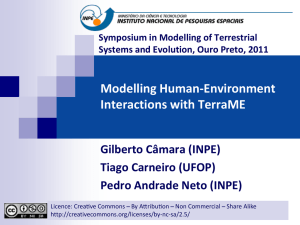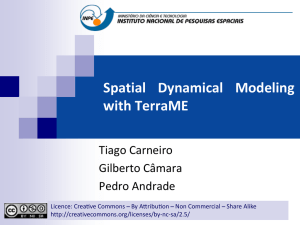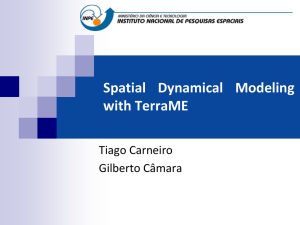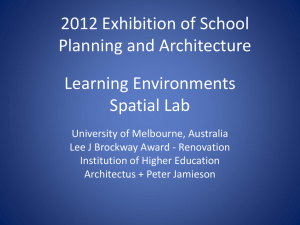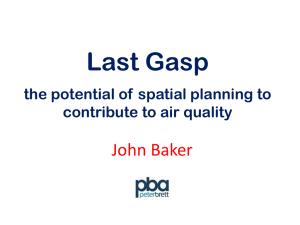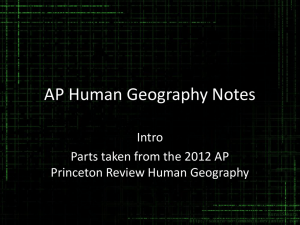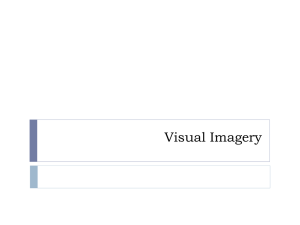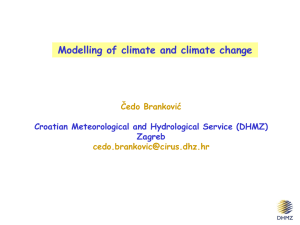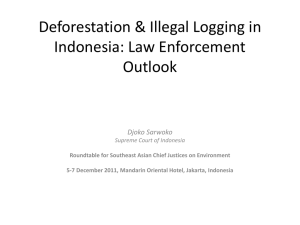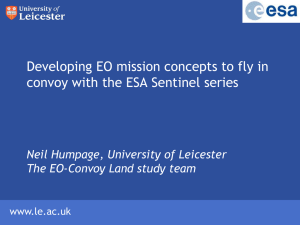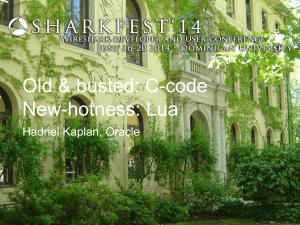Introduction to Spatial Dynamical Modelling
advertisement
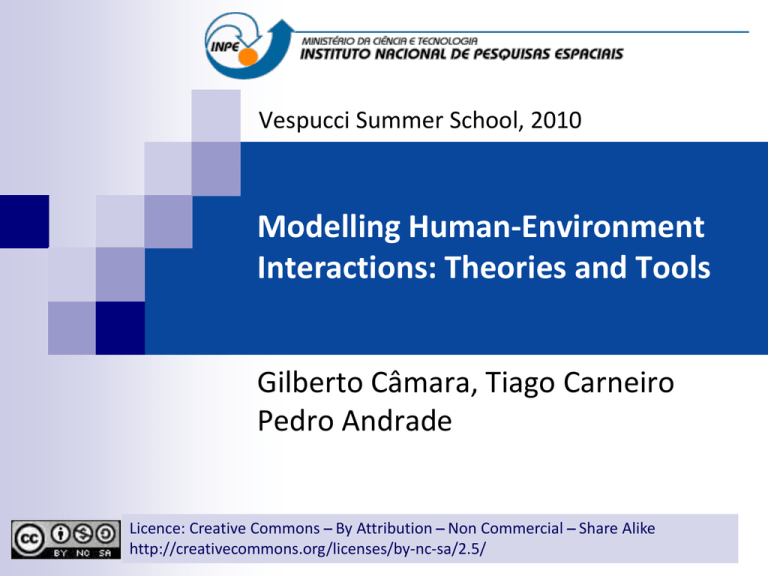
Vespucci Summer School, 2010 Modelling Human-Environment Interactions: Theories and Tools Gilberto Câmara, Tiago Carneiro Pedro Andrade Licence: Creative Commons ̶̶̶̶ By Attribution ̶̶̶̶ Non Commercial ̶̶̶̶ Share Alike http://creativecommons.org/licenses/by-nc-sa/2.5/ "We went to explore the Moon, and in fact discovered the Earth." Eugene Cernan photo: NASA Brazil: a natural knowledge economy Deforestation cut by 300% (2005-09) World leader in tropical agriculture Best technology in biofuels 46% of energy is renewable A Vision for INPE in the 21st Century Brazil will be an environmental power and the first developed nation in the tropics INPE will be a world-class centre in Space and Environment R&D for the tropical region Energy Agriculture Ecosystems Space technology can add value to Brazil´s natural knowledge economy Megacities Climate change Weather and natural disasters INPE: CONVERTING DATA INTO KNOWLEDGE SATELLITES Earth observation, scientific, and data collection satellites GROUND SYSTEMS Satellite control, reception, processing and distribution of satellite data ANALYSIS AND MODELLING Space Weather, Weather Prediction and Earth System Science SOCIETAL BENEFITS Innovative products to meet Brazil´s needs Monitoring Deforestation in Amazonia DETER: 15-day alerts of newly deforested large areas Outline Monday AM Lecture: Modelling human-environment interactions Hands-on: Creating a cellular automata model in TerraME Monday PM Lecture: Complex Systems and Emergence Hands-on: Game of Life, Drainage, Schelling´s Segregation Tuesday AM Lecture: Game Theory, Evolution of Cooperation Hands-on: Iterated and Spatial Prisioner´s Dillema Tuesday PM Lecture: Governing the commons Hands-on: Management of common pool resources Wed AM Groupwork: Conceptual models for management of common pool resources Our Earth is a Unique Planet in the Solar System Runaway greenhouse :: No water cycle to remove carbon from atmosphere Earth Harbor of Life Loss of carbon :: No lithosphere motion on Mars to release carbon Earth is unique in our solar system in its capacity to sustain highly diversified life from Guy Brasseur (NCAR) By the Year 2050… 9 billion people: 6 billion tons of GHG and 60 million tons of urban pollutants. Resource-hungry: We will withdraw 30% of available fresh water. Risky living: 80% urban areas, 25% near earthquake faults, 2% in coast lines less than 1 m above sea level. The fundamental question of our time How is the Earth’s environment changing, and what are the consequences for human civilization? fonte: IGBP Sustainability Science Core Questions How can the dynamic interactions between nature and society be better incorporated in emerging models and conceptualizations that integrate the earth system, human development and sustainability? How are long-term trends in environment and development, including consumption and population, reshaping naturesociety interactions in ways relevant to sustainability? What determines vulnerability/resilience of nature-society interactions for particular places and for particular types of ecosystems and human livelihoods? Source: Sustainability Science Workshop, Friibergh, SE, 2000 Global Land Project • What are the drivers and dynamics of variability and change in terrestrial humanenvironment systems? • How is the provision of environmental goods and services affected by changes in terrestrial humanenvironment systems? • What are the characteristics and dynamics of vulnerability in terrestrial humanenvironment systems? Impacts of global land change More vulnerable communities are those most at risk Human actions and global change photo: C. Nobre Global Change Where are changes taking place? How much change is happening? Who is being impacted by the change? What is causing change? photo: A. Reenberg source: Global Land Project Science Plan (IGBP) GDP per Person in Western Europe (1-2000 AD) from Guy Brasseur (NCAR) ESSL - The Earth & Sun Systems Laboratory Perturbations by humans are quasi-exponential ESSL - The Earth & Sun Systems Laboratory from Guy Brasseur (NCAR) from Jackie McGlade (EEA) Can we avoid that this…. Source: Carlos Nobre (INPE) Fire... ….becomes this? Source: Carlos Nobre (INPE) ~230 scenes Landsat/year Deforestation in Amazonia What is a Model? Deforestation in Amazonia in 2020? simplified representation of a process Model = entities + relations + attributes + rules Computational models Connect expertise from different fields Make the different conceptions explicit If (... ? ) then ... Desforestation? Computational models Connect expertise from different fields Make the different conceptions explicit Territory (Geography) Money (Economy) Modelling (GIScience) Culture (Antropology) Modelling and Public Policy External Influences System Ecology Economy Politics Scenarios Policy Options Decision Maker Desired System State Earth as a system Physical Climate System Climate Change Atmospheric Physics/Dynamics Ocean Dynamics Terrestrial Energy/Moisture Human Activities Global Moisture Marine Biogeochemistry Terrestrial Ecosystems Tropospheric Chemistry Biogeochemical Cycles (from Earth System Science: An Overview, NASA, 1988) Soil CO2 Land Use CO2 Pollutants images: USGS Slides from LANDSAT Modelling Human-Environment Interactions How do we decide on the use of natural resources? 1973 1987 2000 Aral Sea Can we describe and predict changes resulting from human decisions? What computational tools are needed to model humanenvironment decision making? We need spatially explicit models to understand human-environment interactions Nature: Physical equations Describe processes Society: Decisions on how to Use Earth´s resources Dynamic Spatial Models f (It) f (It+1) F f (It+2) f ( It+n ) F .. “A dynamical spatial model is a computational representation of a real-world process where a location on the earth’s surface changes in response to variations on external and internal dynamics” (Peter Burrough) Dynamic Spatial Models Forecast tp - 20 tp - 10 tp Calibration Source: Cláudia Almeida Calibration tp + 10 Which is the better model? Uncertainty on basic equations Limits for Models Social and Economic Systems Quantum Gravity Particle Physics Living Systems Global Change Chemical Reactions Hydrological Models Solar System Dynamics Meteorology Complexity of the phenomenon source: John Barrow (after David Ruelle) How do we decide on the use of natural resources? Soybeans Loggers Competition for Space Small-scale Farming Source: Dan Nepstad (Woods Hole) Ranchers What Drives Tropical Deforestation? % of the cases 5% 10% 50% Underlying Factors driving proximate causes Causative interlinkages at proximate/underlying levels Internal drivers *If less than 5%of cases, not depicted here. source:Geist &Lambin (Université Louvain) Human-enviromental systems [Ostrom, Science, 2005] Types of goods Source: E Ostrom (2005) Institutional analysis Identify different actors and try to model their actions Farms Settlements 10 to 20 anos Recent Settlements (less than 4 years) Source: Escada, 2003 Old Settlements (more than 20 years) Institutional arrangments in Amazonia Prisoner’s Dilemma: Game Theory Did you lie to Congress about WMD in Iraq? BLAIR (Labour Party) Confess Not Confess Confess 12 years each 4 years for GOP and 16 years for Labour 16 years for GOP and 4 years for Labour 8 years for both parties BUSH (GOP) Not Confess Question #1 for Nature-Society models What ontological kinds (data types) are required for nature-society models? Fields Cells (objects) Concepts for spatial dynamical models Events and processes Resilience Concepts for spatial dynamical models vulnerability degradation Concepts for spatial dynamical models biodiversity sustainability and much more… Human-environmental models need to describe complex concepts (and store their attributes in a database) Question #2 for Nature-Society models What models are needed to describe human actions? Clouds: statistical distributions Clocks, clouds or ants? Clocks: deterministic equations Ants: emerging behaviour Statistics: Humans as clouds y=a0 + a1x1 + a2x2 + ... +aixi +E Establishes statistical relationship with variables that are related to the phenomena under study Basic hypothesis: stationary processes Example: CLUE Model (University of Wageningen) Fonte: Verburg et al, Env. Man., Vol. 30, No. 3, pp. 391–405 Spatially-explicit LUCC models Explain past changes, through the identification of determining factors of land use change; Envision which changes will happen, and their intensity, location and time; Assess how choices in public policy can influence change, by building different scenarios considering different policy options. Driving factors of change (deforestation) source: Aguiar (2006) Category Demographic Technology Variables Population Density Proportion of urban population Proportion of migrant population (before 1991, from 1991 to 1996) Number of tractors per number of farms Percentage of farms with technical assistance Agrarian strutucture Percentage of small, medium and large properties in terms of area Percentage of small, medium and large properties in terms of number Infra-structure Distance to paved and non-paved roads Distance to urban centers Distance to ports Economy Distance to wood extraction poles Distance to mining activities in operation (*) Connection index to national markets Percentage cover of protected areas (National Forests, Reserves, Political Presence of INCRA settlements Number of families settled (*) Environmental Soils (classes of fertility, texture, slope) Climatic (avarage precipitation, temperature*, relative umidity*) Linear and spatial lag regression models Y Xβ ε , ~ N( 0, ) 2 Y WY Xβ where: Y is an (n x 1) vector of observations on a dependent variable taken at each of n locations, X is an (n x k) matrix of exogenous variables, is an (k x 1) vector of parameters (estimated regression coefficients), and is (n x 1) an vector of disturbances. W is the spatial weights matrix, the product WY expresses the spatial dependence on Y (neighbors), is the spatial autoregressive coefficient. Statistics: Humans as clouds MODEL 7: Variables source: Aguiar (2006) R² = .86 PORC3_AR Description Percentage of large farms, in terms of area LOG_DENS Population density (log 10) PRECIPIT stb p-level 0,27 0,00 0,38 0,00 -0,32 0,00 LOG_NR1 Avarege precipitation Percentage of small farms, in terms of number (log 10) 0,29 0,00 DIST_EST Distance to roads -0,10 0,00 LOG2_FER Percentage of medium fertility soil (log 10) -0,06 0,01 PORC1_UC Percantage of Indigenous land -0,06 0,01 Statistical analysis of deforestation Demand scenarios 40000 35000 30000 Rate (km2/year) CLUE modeling framework 25000 Decreasing 20000 Baseline Increasing 15000 10000 5000 Year 100 x 100 km2 100 x 100 km2 25 x 25 km2 20 20 20 18 20 16 20 14 20 12 20 10 20 08 20 06 20 04 20 02 20 00 19 98 19 96 19 94 19 92 19 90 19 88 0 Scenario exploration: linking to process knowledge ManausBoa Vista Santarém Cellular database construction Exploratory analysis and selection of subset of variables Porto Velho- São Felix/ Manaus Iriri Humaitá Apuí BR 163 Boca do Cuiabá-Santarém Acre Aripuanã Scenario exploration Construction of alternative models for each group/partition/ land-use Alternative CLUE runs 1997 to 2020 Comparison to real data and new frontiers process knowledge Scenarios for deforestation in Amazonia (2020) Agents as basis for complex systems An agent is any actor within an environment, any entity that can affect itself, the environment and other agents. Agent: flexible, interacting and autonomous Agent-Based Modelling Representations Goal Communication Communication Action Perception Environment source: Nigel Gilbert Agents: autonomy, flexibility, interaction Synchronization of fireflies Bird Flocking No central authority: Each bird reacts to its neighbor Bottom-up: not possible to model the flock in a global manner. It is necessary to simulate the INTERACTION between the individuals Requirement #2 for Nature-Society models Models need to support both statistical relations (clouds) and agents (ants) [Andrade-Neto et al., 2008] Question #3 for Nature-Society models What types of spatial relations exist in nature-society models? Natural space is (usually) isotropic Societal space is mostly anisotropic Rondonia 1975 1986 Societal spaces are anisotropic Which spatial objects are closer? Which cells are closer? [Aguiar et al., 2003] Requirement #3 for Nature-Society models: express anisotropy explicitly Euclidean space Open network Closed network D1 D2 [Aguiar et al., 2003] Question #4 for Nature-Society models How do we combine independent multi-scale models with feedback? Models: From Global to Local Athmosphere, ocean, chemistry climate model (resolution 200 x 200 km) Atmosphere only global climate model (resolution 50 x 50 km) Regional climate model (resolution 10 x 10 km) Hydrology, Vegetation Soil Topography (e.g, 1 x 1 km) Regional land use change Socio-economic changes Adaptation (e.g., 100 x 100 m) Nature-Society models should be multiscale, multi-approach grid of 1 x 1 km2 grid of 25 x 25 km2 National level - the main markets for Amazonia products (Northeast and São Paulo) and the roads infrastructure network; Regional level - for the whole Brazilian Amazonia, 4 million km2; Local level - for a hot-spot of deforestation in Central Amazonia, the Iriri region, in São Felix do Xingu, Pará State [Moreira et al., 2008] Multi-scale modelling: hierarchical relations need to be described Environmental Modeler [Engelen, White and Nijs, 2003] CLUE model [Veldkamp and Fresco, 1996] Not all multiscale models have nested grids Requirement #4 for Nature-Society models: support multi-scale modelling using explicit relationships Express explicit spatial relationships between individual objects in different scales [Moreira et al., 2008] [Carneiro et al., 2008] Question #5 for Nature-Society models photos: Isabel Escada How can we express behavioural changes in human societies? Small Farmers When a small farmer becomes a medium-sized one, his behaviour changes Medium-Sized Farmers Societal systems undergo phase transitions Isabel Escada, 2003 Farms Settlements 10 to 20 anos Recent Settlements (less than 4 years) Old Settlements (more than 20 years) [Escada, 2003] Requirement #5 for Nature-Society models: Capture phase transitions latency > 6 years Deforesting Newly implanted Small Farmers Deforestation > 80% Year of creation Slowing down Iddle Deforestation = 100% photos: Isabel Escada Deforesting Deforestation > 60% Year of creation Slowing down Iddle Deforestation = 100% Medium-Sized Farmers TerraME: Computational environment for developing nature-society models Cell Spaces Support for cellular automata and agents TerraME: Modular modelling tool [Carneiro, 2006] TerraME´s way: Modular components [Carneiro, 2006] 1. Get first pair 2. Execute the ACTION 3. Timer =EVENT 1. 1:32:00 Mens. 1 2. 1:32:10 Mens. 3 3. 1:38:07 Mens. 2 4. 1:42:00 Mens.4 ... return value true 4. timeToHappen += period Describe spatial structure latency > 6 years Describe temporal structure Deforesting Newly implanted Year of creation Iddle Slowing down Deforestation = 100% Describe rules of behaviour Describe spatial relations Spatial structure in TerraME: Cell Spaces integrated with databases Spatial Relations in TerraME [Moreira et al., 2008] Spatial relations between entities in a nature-societal model are expressed by a generalized proximity matrix (GPM) w11 w W 21 w31 w41 w12 w13 w14 w22 w23 w24 w32 w33 w34 w42 w43 w44 TerraME: multi-scale modelling using explicit relationships [Moreira et al., 2008] [Carneiro et al., 2008] Scale 1 father up-scaling children Scale 2 Generalized proximity matrices express explicit spatial relationships between individual objects in different scales w11 w W 21 w31 w41 w12 w13 w14 w22 w23 w24 w32 w33 w34 w42 w43 w44 TerraME uses hybrid automata to represent phase transitions A hybrid automaton is a formal model for a mixed discrete continuous system (Henzinger, 1996) Hybrid Automata = state machine + dynamical systems State B State A Flow Condition Jump condition Flow Condition Hybrid automata: simple land tenure model Farmer gets parcel SUBSISTENCE deforest>=60% CATTLE Deforest 20%/year Extensive cattle raising LAND REFORM redistribution Land exhaustion Land revision ABANDONMENT RECLAIM Land registration Public repossession Regrowth STATE Flow Condition Jump Condition Transition SUBSISTENCE Deforest 10% of land/year Deforest > 60% CATTLE CATTLE Extensive cattle raising Land exhaustion ABANDONMENT ABANDONMENT Forest regrowth Land revision RECLAIM RECLAIM Public repossession Land registration LAND REFORM LAND REFORM Land distribution Farmer gets parcels SUBSISTENCE TerraME Software Architecture RondôniaModel São Felix Model Amazon Model Hydro Model TerraME Language TerraME Compiler TerraME Virtual Machine TerraLib TerraME Framework C++ Signal Processing librarys C++ Mathematical librarys C++ Statistical librarys TerraLib [Carneiro, 2006] Where is Lua? Inside Brazil Petrobras, the Brazilian Oil Company Embratel (the main telecommunication company in Brazil) TerraME Programming Language: Extension of LUA many other companies LUA the language of choice for computer games is Outside Brazil Lua is used in hundreds of projects, both commercial and academic CGILua still in restricted use until recently all documentation was in Portuguese Lua and the Web source: the LUA team [Ierusalimschy et al, 1996] TerraME programming environment TerraME INTERPRETER • model syntax semantic checking • model execution TerraView • data acquisition • data visualization • data management • data analysis LUA interpreter TerraME framework data model model TerraME/LUA interface data Eclipse & LUA plugin • model description • model highlight syntax MODEL DATA Model source code TerraLib database [Carneiro, 2006]
